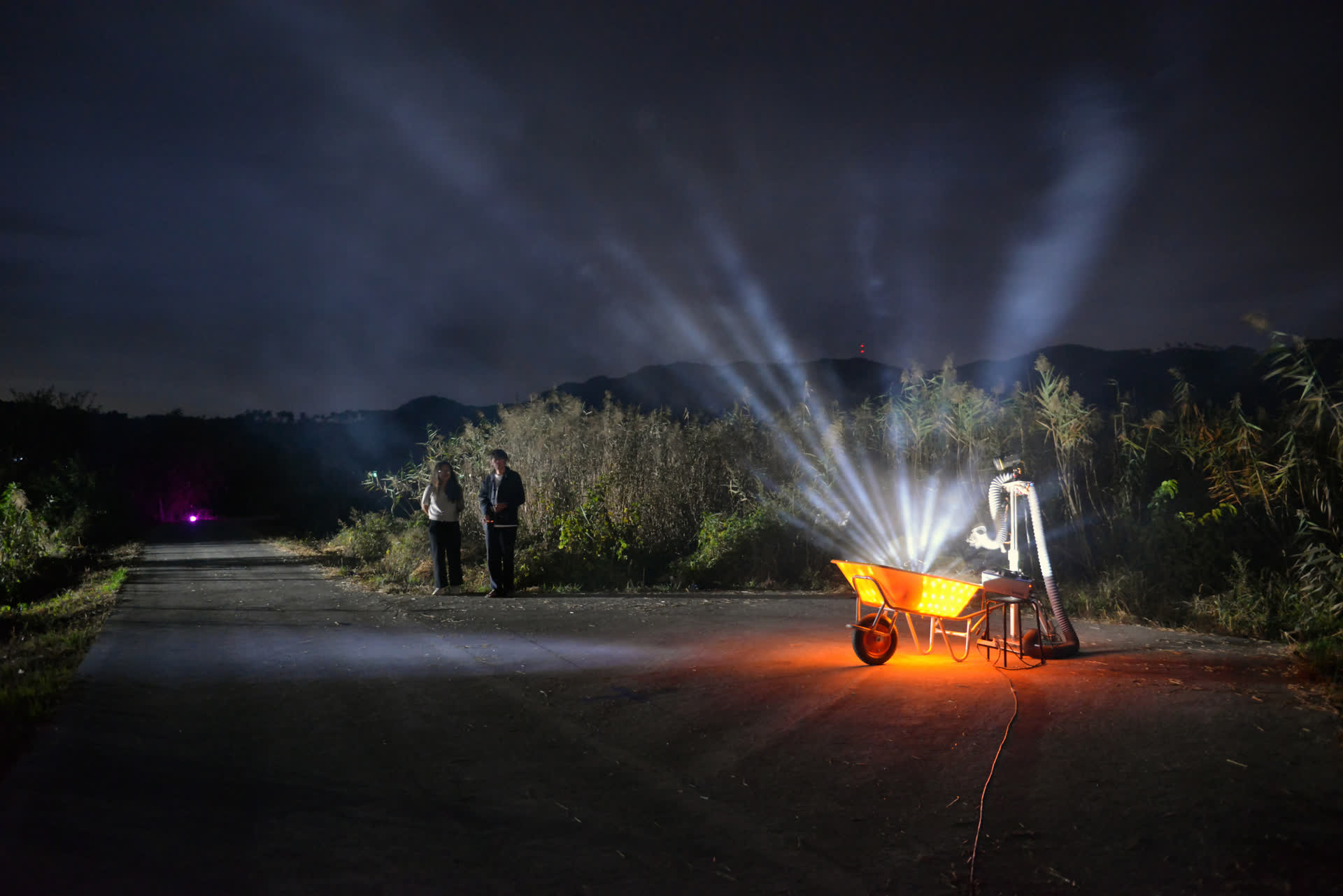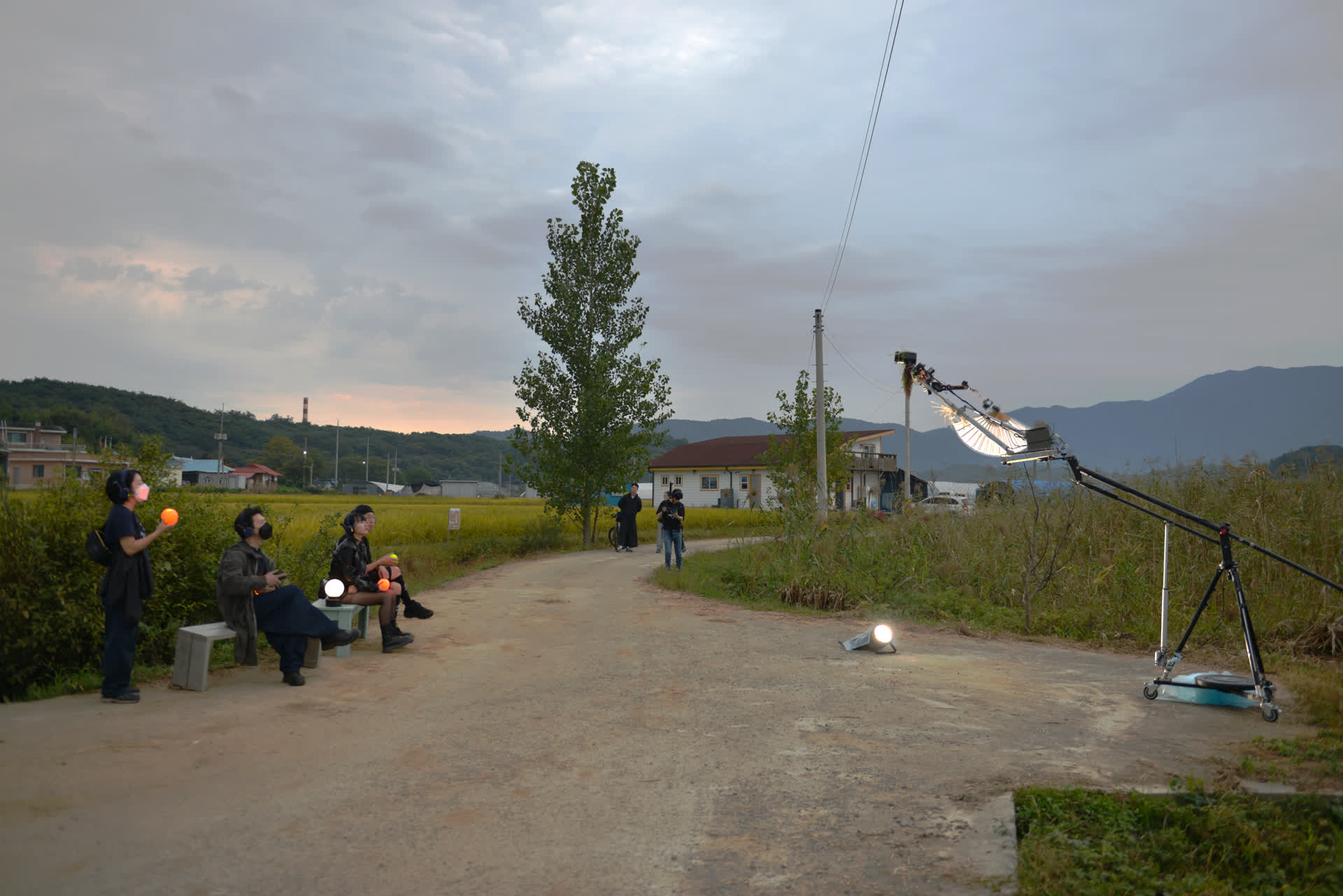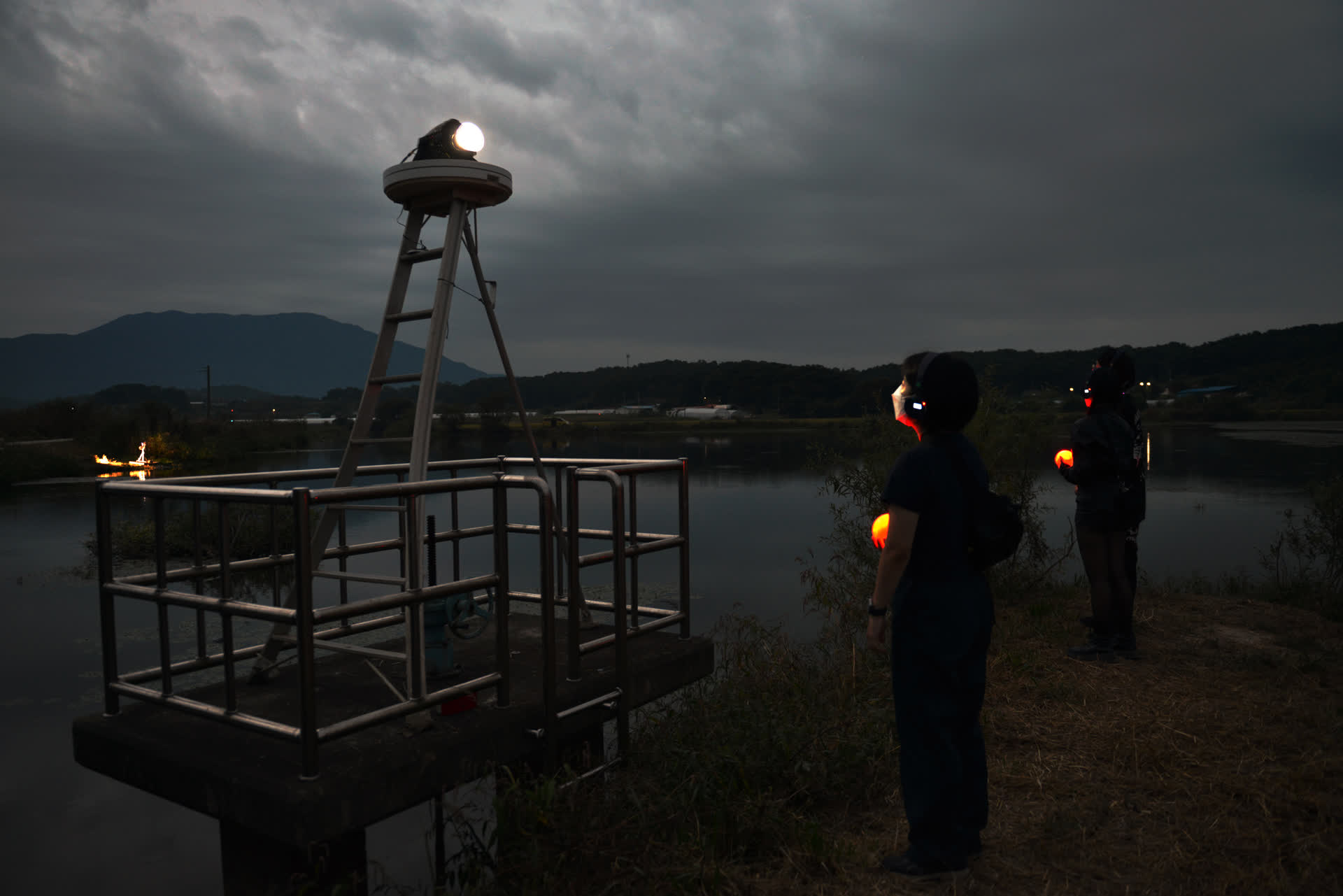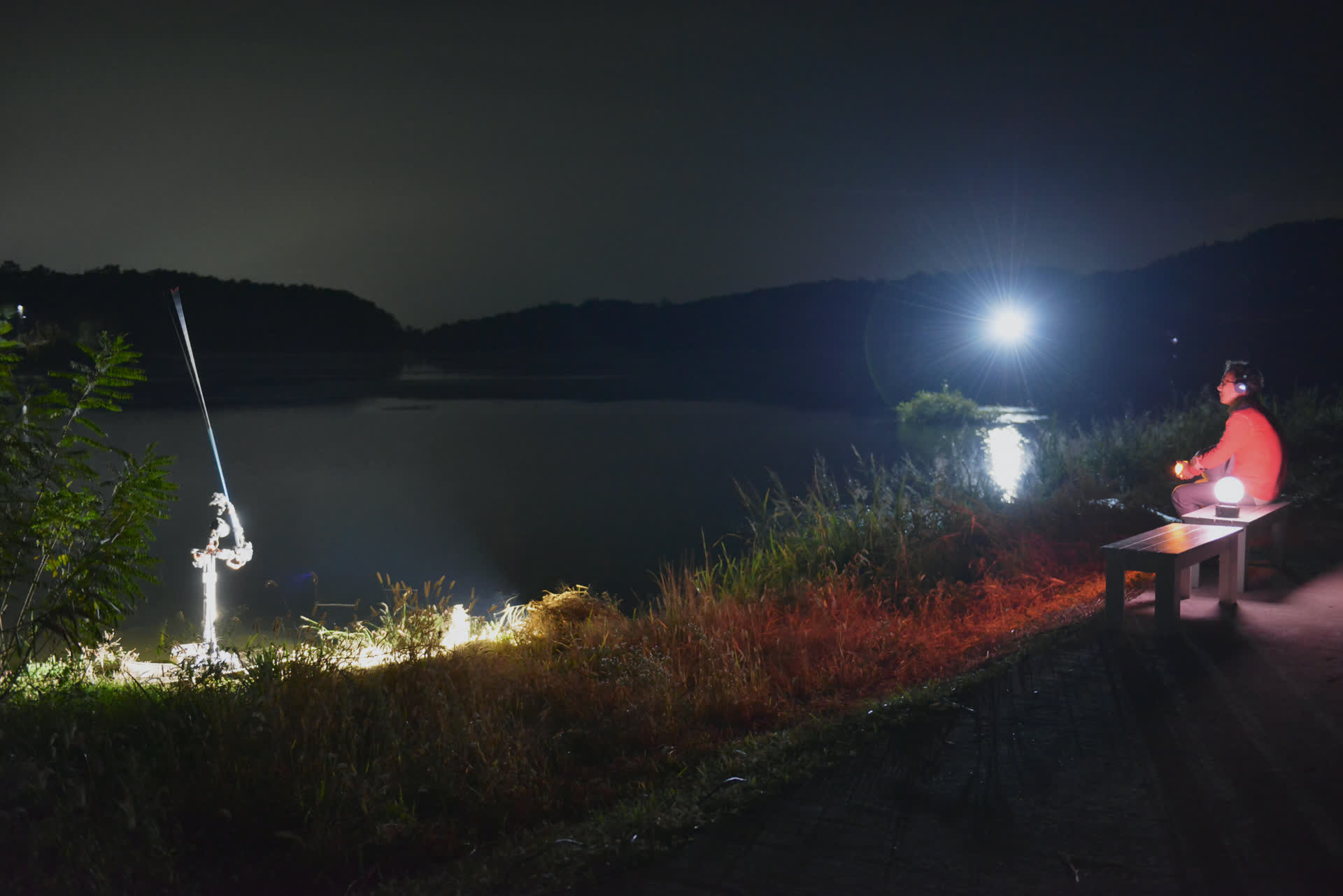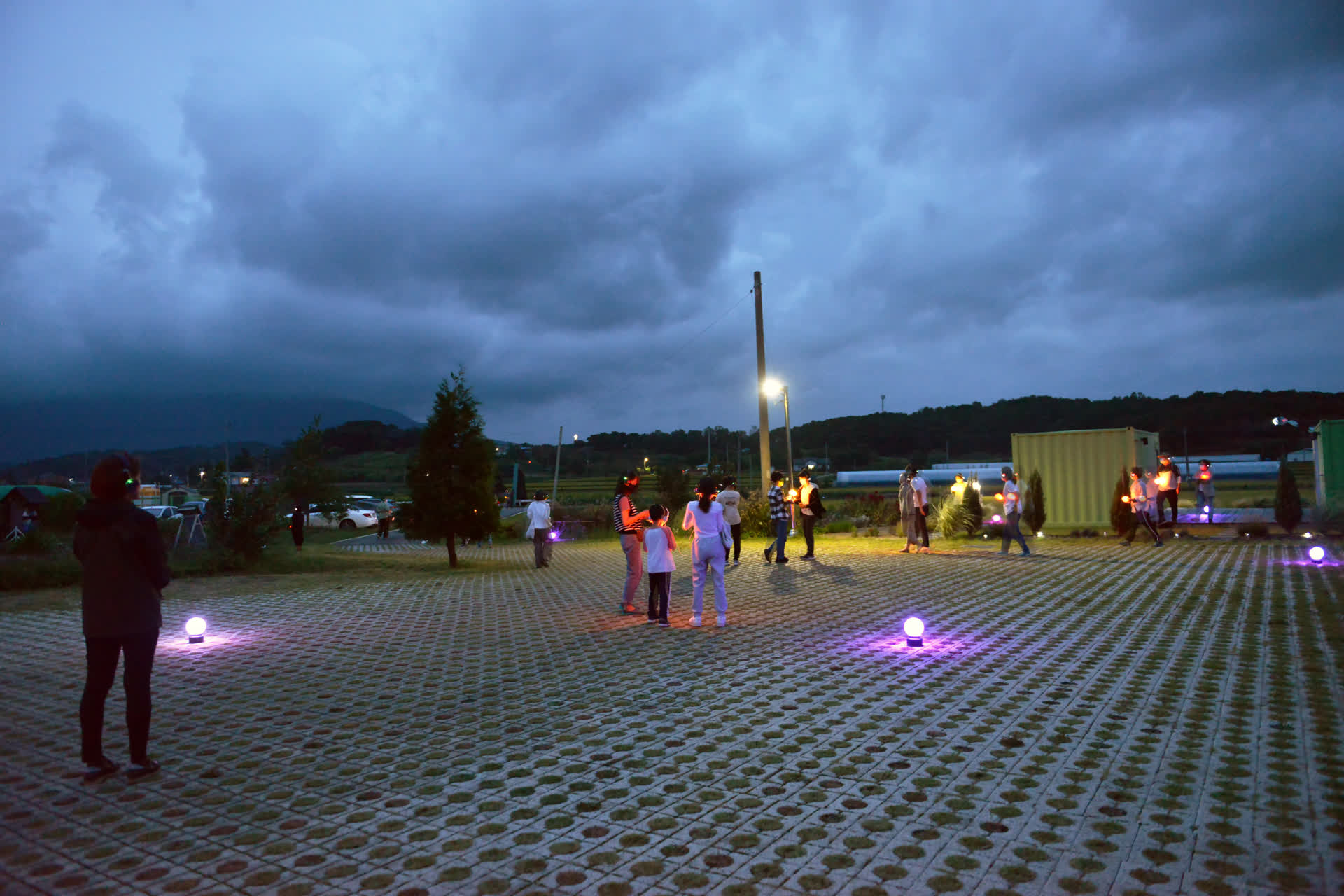LocationHongDong Reservoir
DateOctober 1 – 3, 2022
Concept, Direction, Sound, Technical DirectorKwon Byung-junArtistKwon Byung-jun with AITechnicalBaek Ju-hongTechnical SupportOh Eui-jin, Yoon Joong-sun, Cho Soo-ahRecording and EditingKim Geun-chae (Punk Tire Studio)PhotographyJeon Byung-chul, Ok Sang-hoonVideo RecordingJang Ji-namProducersPark Ji-sun, Choi Bong-min (Producer Group Dot)Voice CastKwon Byung-jun, Park Sun-hee, Park Hyun-ji, Sung Soo-yeon, Woo Beom-jin, Lee Kyung-gu, Cho Woong-cheolChildren's Voice CastPark Jun-woo, Park Hae-binSpecial AppearanceYu Jin-gyu
Byungjun Kwon, music is something that is done together. It's about enjoying it together and creating it together. In 2014, he proposed a project to find "sounds that had never been heard before" with interdisciplinary artists such as visual artists, musicians, architects, instrument makers, and landscape experts, and worked on it for almost a year. 1 In fact, this project was not about finding new sounds, but about finding a fundamental understanding of sound. It was similar to the process in which Renaissance painters made their own paint in their own way. Nowadays, when we paint, we use paint that has already been made into a product, but before that, painters made it themselves. Painters had a basic knowledge of chemistry and had a "chemical sense" of what to expect when other substances were mixed or how much a substance would harden when it combined with oxygen.They obtained vermilion from cinnabar (red) and ultramarine from lapis lazuli (blue). To obtain a dazzling white, they needed lead carbonate powder. To make this, painters were poisoned by lead, and some even lost their lives. They also used unsaturated fatty acids. Unsaturated fatty acids formed a hard film over time, which made delicate brush strokes look three-dimensional.
We should also understand Kwon’s search for sound in this way. Renaissance painters did not consciously understand science and art in an interdisciplinary way. Art has long been connected not only to society, econ- omy, and politics, but also to science and technology.Just like painters who were dissatisfied with the paint sold in tubes, those who felt the limitations of the sounds produced by traditional instruments while standing in a music store can do anything to obtain the sound they want. They can dismantle and recombine existing instruments or choose entirely new media. But when the chosen medium is a robot, can we still call it sound (or paint)? Anything can become a medium and a way of expression.The same is true when it is not a reproduction. In this process, technology, science, and mathematics inevitably follow. For artists, this is not training to become scientists and en- gineers, but a process of developing a scientific-technological-mathematical sense. In this process, sound can combine with something else to produce unexpected results. What Kwon Byung-joon wants to enjoy together and create together is this process.
권병준에게 음악은 같이 하는 것이다. 더불어 즐기는 것이고 같이 만드는 것이다. 그는 2014년에 미술가, 음악가, 건축가, 악기 제작자, 조경 전문가 등 융복합적 예술가들과 '이제까지 없었던 소리'를 찾기 위한 작업을 제안했고 1년 가까이 실행했다. 사실 이 작업은 새로운 소리를 찾는다기보다는 소리에 대한 근본적인 이해를 찾는 작업이었다. 그것은 흡사 르네상스 시대 화가들이 자기만의 방법으로 물감을 만들어 쓰는 과정과 같았다. 지금 우리는 그림을 그릴 때 이미 상품으로 만들어진 물감을 사용하지만, 그 이전에는 화가들이 직접 만들었다. 화가들은 화학에 대한 기본 지식이 있었고, 적어도 다른 물질끼리 섞일 때 예상되는 반응이나 물질이 산소와 결합했을 때 굳는 정도에 대한 '화학적 감각'을 가지고 있었다. 진사에서 버밀리언(붉은색)을 얻었고, 청금석에서 울트라마린(감청색)을 얻었다. 눈부신 흰색을 얻기 위해서는 탄산납 가루가 필요했다. 이것을 만들기 위해 화가들은 납중독에 걸렸고, 심지어 그로 인해 목숨을 잃기까지 했다. 불포화지방산도 이용했다. 불포화지방산은 시간이 지나면 굳으면서 단단한 막을 형성해 섬세한 붓 터치를 입체적으로 보이게 했다.
권병준의 소리 찾기도 우리는 그렇게 이해해야 한다. 르네상스 화가들이 의식적으로 과학과 미술을 융복합적으로 이해한 것이 아니었다. 이미 예술은 사회, 경제, 정치뿐 아니라 과학, 기술과도 오래전부터 친했다. 튜브에 든 판매용 물감에 만족하지 못하는 화가들처럼, 악기점에서 산 악기에서 어떤 소리의 한계를 느낀 사람들은 당연히 자기가 원하는 소리를 얻기 위해 무슨 짓이든 할 수 있다. 기존 악기를 해체하고 다르게 조합하거나, 아예 새로운 매체를 선택할 수도 있다. 그런데 그 선택한 매체가 로봇일 때, 우리는 그것을 소리(또는 물감)가 아니라고 말할 수 있을까? 그 무엇이라도 표현의 방법과 매체가 될 수 있다. 그것이 재현이 아닐 때도 마찬가지다. 이런 과정에는 기술과 과학, 그리고 수학이 뒤따를 수밖에 없다. 예술가에게 이것은 과학자와 기술자가 되는 훈련이 아니라 과학-기술-수학적 감각화의 과정일 것이다. 그 과정에서 소리는 소리를 넘어 다른 무엇과 결합해서 전혀 예상하지 못했던 결과를 낳을 수도 있다. 권병준이 더불어 즐기고 싶은 것이 이것이고 같이 만들고자 하는 것 역시 이것이다.
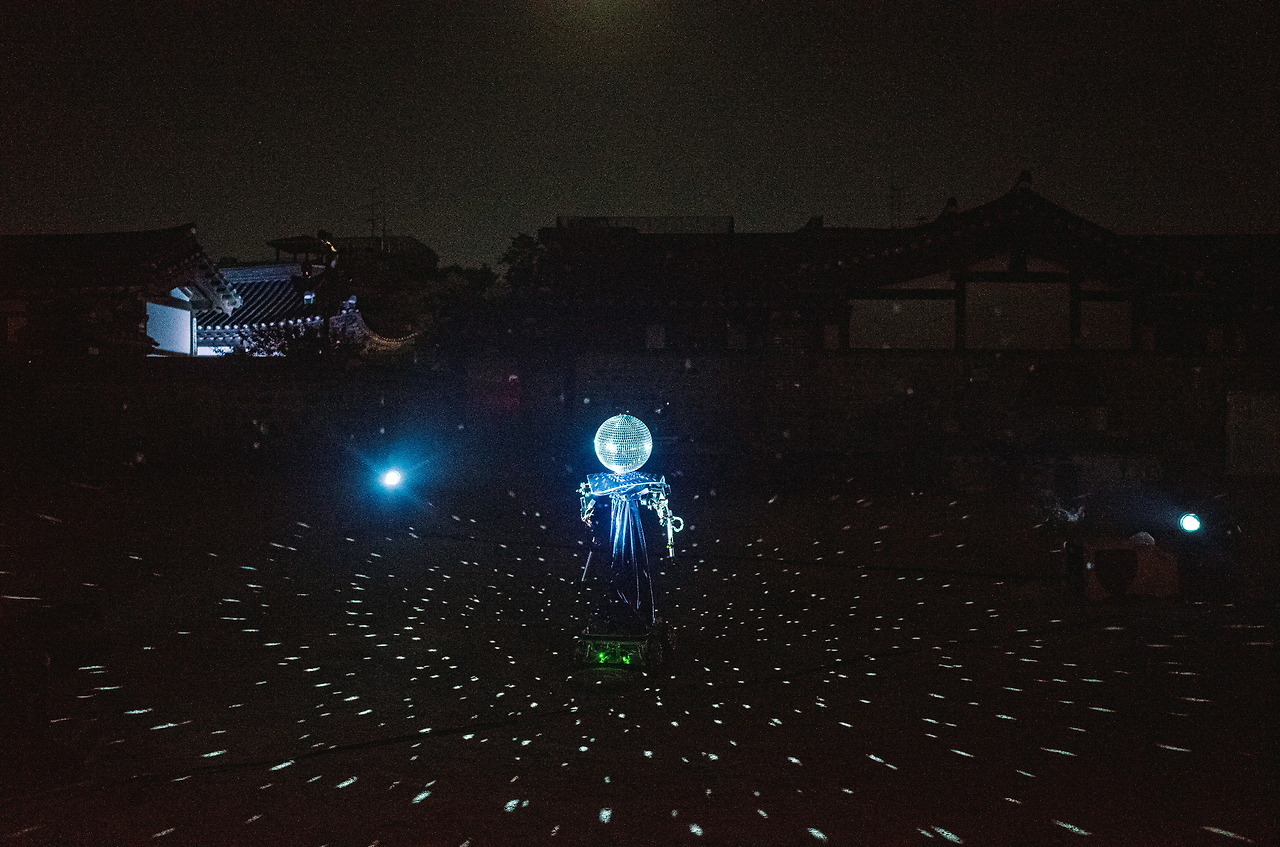
Source: Kim Min-gwan, "Kwon Byung-jun, <The Phantom Troupe 'Spending a Serious Night'>: A Night of Convergence and Omission," Art Scene, December 1, 2012
In a mountain village nestled within an unknown passageway where a time capsule is hidden, beings from different times gather. As darkness falls, the forest spirit grants these ghost-like entities a human voice to pass on their traces. Leaving behind the love story of newly possessed lovers, the audience crosses a narrow bridge on an increasingly dense forest path and reaches the House of Reversal. This place echoes with the voice of a spirit who, seeing the reflection of their younger self in a well, leapt into its depths. The sound is so beautiful that it allows one to love even the distorted reflection of oneself bouncing back through time. As time passes, a child becomes an old man, and the old man who crossed the bridge sings of his irreversible regrets like a shooting star, vanishing into thin air.In the village space initiated by the echoes heard in the House of Reversal, there are several robots born from "mechanical medium surgery," alongside operating rooms and rehabilitation treatment rooms. Conversations between Nael and Philip, who appear as a white and black bird, can be heard as they watch the shadows of the robots being operated on. These characters among the ghosts of the play remain merged with natural entities, not robots, and can freely traverse time and space. The forest's House of Reversal touches the Well of Time, where echoes are always heard. The robots, having completed their procedures, perform calisthenics in the beautiful moonlight to the rhythm of a funeral march and later dance together to the music of a spirited dance in the courtyard.
타임캡슐이 숨겨져 있는 미지의 통로에 다른 시간의 존재들이 모여 있는 산속마을이 있다. 어둠이 내리면 숲의 정령은 그 유령같은 존재들에게 그들의 흔적을 전달할 수 있는 인간의 목소리를 부여한다. 관객은 새로 빙의된 연인들의 사랑이야기를 뒤로하고 더욱 울창해지는 밤의 숲길에 외나무다리를 지나 반전의 집에 도달한다. 그곳은 우물에 비친 자신의 어릴 적 모습을 찾아 우물속으로 뛰어내린 어느 혼령의 메아리가 들려지는 곳이다. 그 소리는 너무나 아름다워서 부딪쳐 돌아오는 시간 속 왜곡된 자신의 모습도 사랑할 수 있게 하는 황홀경이다. 시간을 넘어 아이는 노인이 되고 외나무다리를 건너던 노인은 메아리만을 만들고 살아온 자신의 돌이킬 수 없는 회한을 노래하며 유성처럼 사라진다.반전의 집에서 들은 메아리의 화두로 시작하는 마을의 공간에는 ‘기계식 영매 접합술’로 탄생한 여러 로봇들과 함께 수술실, 재활 치료실이 있으며 시술중인 로봇들의 그림자를 바라보며 흰새와 검은새로 분한 나엘과 필립의 대화가 들려온다. 그들은 극중의 유령들 중 로봇이 아닌 자연의 존재와 합치되어 남아 있으며 자유로이 시공간을 오갈 수 있다. 숲속의 반전의 집은 시간의 우물과 닿아 있고 그곳에선 언제나 메아리가 들려온다. 시술이 끝난 로봇들은 예쁜 달밤에 구령에 맞춰 체조를 하며 이후 마당에서 펼쳐지는 살풀이 음악에 맞춰 다같이 춤춘다.
The ontology of the West is now for Kwon Byung-jun not about "existence," but about the "moment of love" and "sharing." This sharing is not based on the law of exchange but on an act for the sake of absence, forsomething empty and causeless. We chase after the sound that moves to- wards that non-place. Sound is about being together (與衆樂樂) and enjoying together (與人同樂). It is not about any particular space, but rather a dance of unnamed moments. It is also a long-standing question from East Asia that has explored the relationship between "existence" and the "existentialist" in Western metaphysics for the past 3,000 years.
서구의 존재론은 이제 권병준에게 ‘실재’가 아니라 ‘사랑의 순간’이고, ‘나누는 것’ 이다. 그 나눔은 교환의 법칙에 의해서가 아니라 부재를 위해서, 원인이 없는, 비어있는 것을 위한 행위다. 우리는 그 비장소를 향해 움직이는 소리를 쫓아간다. 소리는 같이하는 것이다 (與衆樂樂). 그리고 소리는 같이 즐기는 것이다(與人同樂). 어떤 공간도 아니고, 이름이 없는 시간의 춤, 그것은 또한 ‘존재’와 ‘존재자’의 관계를 탐구해온 3000년 동안의 서양 형이상학에 대한 동아시아의 오랜 질문이기도 하다.
© 2024 Byungjun Kwon All rights reserved.
